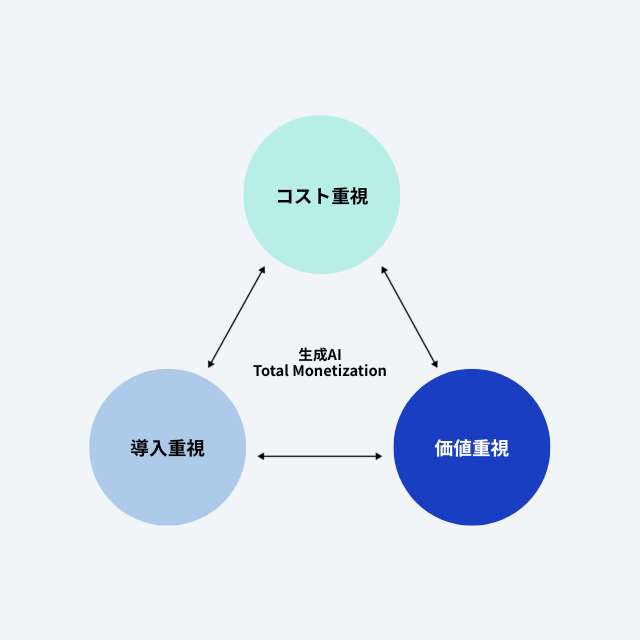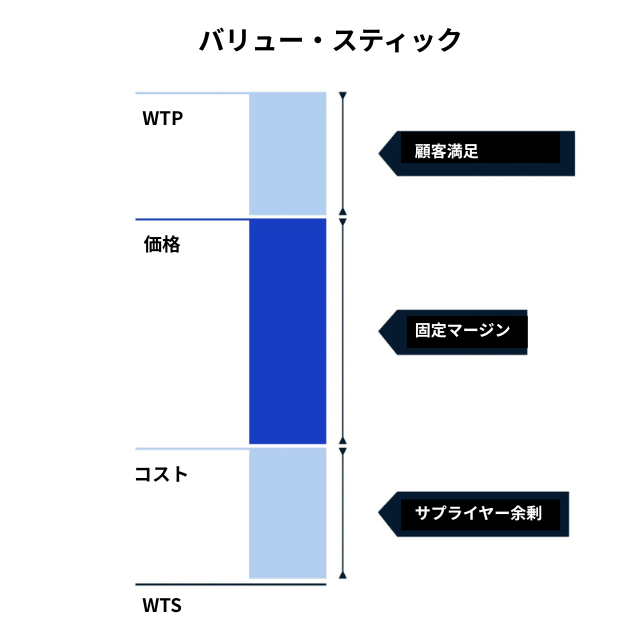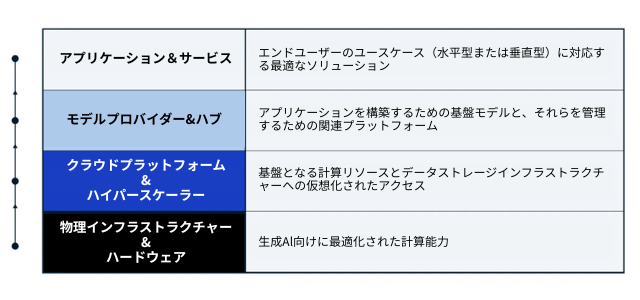生成AI収益化の現状調査レポート
生成AIの収益化:なぜ多くのSaaS企業が機会を逃しているのか、そしてその解決策
著者:Michael Mansard(サブスクライブド・インスティテュートEMEA議長)

方法論:本継続的なデータ主導分析では、生成AIを提供する70社以上の収益化戦略を検証しています。 調査・分析および提言は、2024年4月時点のプレスリリース、記事、ベンダーウェブサイトなど公開情報に基づいています。
インサイトを探る
以下のリンクをクリックして、最も興味のあるトピックについて詳しくご覧ください。
2023年は、生成AI(GenAI)が有望な技術から主流のイノベーションへと進化した年として記憶されることでしょう。各社が新たな生成AI製品のリリースを急ぐ中、エンドユーザーも個人・業務の両面でその可能性を模索しています。大きな成功もあれば、失敗例も見受けられます。イノベーションの進展は著しく、それに伴い新たなビジネスモデルも登場しています。
スタンドアロン型のAIソリューションが存在する一方で、既存企業は自社プロダクト群へも生成AIを組み込んでいます。実際、2023年の報告によれば、4社中3社以上のSaaS企業が生成AIの提供を開始または開発中です。
しかし話題が盛り上がる一方で、同じ企業のうち実際にAIソリューションを収益化できているのはわずか15%に過ぎません。多くの企業は市場投入を急ぐあまり、長期的な収益化戦略を十分に検討する前に製品を発表・リリースしています。中には、リリース時点で収益化をまったく考慮しない選択をするケースもあります。
今後本シリーズで事例を詳述しますが、多くの企業は、将来性のある収益化戦略を模索することなく、単純な価格モデルに頼っているのが現状です。生成AIに伴う高コストと低利益率を考慮すると、これは非常にリスクの高い選択と言えます。
また、(ChatGPT Plus、Google One AI Premium、Amazon Q Businessなど)競合製品間の価格競争が、価格設定の微調整だけで生成AIの収益化が可能だという錯覚を与えていますが、実際ははるかに複雑な課題です。
この競争が激化し続ける進化する市場で持続可能な地位を築くため、現代の企業は同様に柔軟なアプローチを採用すべきです。生成AIサービスから収益を生み出すためには、収益化戦略の反復改善が不可欠です。顧客のニーズの変化に合わせて価格を継続的に進化させ、収益と成長を生み出すことで、企業は「Total Monetization」を実現できます。
この新たな市場の誕生を目の当たりにする中、2024年は生成AIの収益化が真に始まる年です。この分野の勝者は、単に「無料で提供する」企業ではなく、Total Monetization戦略を採用する企業です。
では、これらの戦略とは何か、そして企業はどのようにして生成AI収益化を顧客ニーズに合致・適応させ、拡大させていくことができるのでしょうか。
表面上は、現在の収益化アプローチに一定の均一性があるように思えるかもしれません。しかし、70件を超える生成AIサービスの分析から、リアルタイムで進化する多様な戦略の織り成す豊かな構造が明らかになっています。
本シリーズでは、コスト・導入・価値の三角形といった観点から、生成AI市場の進化と、なぜ多くの企業にとって生成AI収益化がいまだに大きな機会損失となっているのかを解き明かしていきます。
生成AI収益化シリーズの続きはこちら:
ほとんどのSaaS企業が生成AI収益化の機会を逃している
企業や個人による生成AIの急速な普及は、その実用的な設計、ユーザー中心のソリューション、シンプルなインターフェースによるものです。しかし、この技術と市場の変化が非常に速いため、生成AI収益化のベストプラクティスに関する明確な指針は追いついていません。
SaaSにおける収益化戦略のテストと反復はもともと難しいものですが、生成AIの場合は迅速な実行と先行事例からの学習が成功の絶対条件です。収益化を後回しにすれば、失敗する確率は非常に高くなります。生成AIの粗利益率は平均してSaaSより10~30ポイント低いため、収益性の確保は困難というのが生成AIサービスの特徴です。
生成AIソリューションを開発・提供する企業にとって、最適な収益化戦略の確立には絶え間ないバランス調整が求められます。当社の調査によれば、企業は次の3つの主要な収益化フォーカス領域の間で、継続的にバランスを取りながら最適解を探るべきと考えます:
- コスト重視型:このアプローチはマージン水準を確保しつつ設定が簡単ですが、顧客価値と無関係です。これにより、収益を逃すか、過剰課金するリスクが生じます。
- 採用重視型:顧客は容易に導入する判断を行えますが、企業側は利益率を犠牲にします(特に後述するSaaSと比較した生成AI特有のコスト構造によるものです)。
- 価値重視型:価値創造と価値獲得の整合性を保ちますが、価値を直接測定し証明するための戦略とツールが必要です。このアプローチは、ほとんどの企業にとって長期的な目標すべきものです。

画像:コスト、採用、価値のバランスを継続的に最適化することで、生成AIの完全な収益化を実現します。
生成AI収益化に「唯一の正解」はありませんが、これら3つの主要フォーカス領域の相互作用と課題を理解することで、戦略の方向性を明確にすることができます。
生成AIのコスト構造は従来のSaaSとは劇的に異なる
従来のSaaSと異なり、生成AIソリューションの本質的な性質として、ユーザーごとのインタラクションやクエリごとに無視できないコストが発生し、限界費用がはるかにダイナミックになります。つまり、生成AIのコストはユーザーのクエリ数に比例して増加する傾向にあります。
SaaS経済においては獲得コスト(Cost of Acquisition)が最重要要素の一つですが、生成AIでは売上原価(Cost of Goods Sold)をより綿密に管理する必要があります。たとえば、OpenAIはChatGPTの運用に1日あたり$700,000を要すると報じられています。同社は年商20億ドルを突破していますが、運用コストが莫大で、売上成長を上回っています。今後の生成AI需要の増大とユースケースの複雑化を鑑みても、コストがすぐに下がることは考えにくい状況です。
これらの天文学的なコストの一因は、生成AIソリューションの開発に必要な研究開発(R&D)です。具体的には、モデルの再トレーニング、推論、AI専門家の人材不足などが挙げられます。運用開始後は、SaaS企業では売上高の約10%を占めるホスティングや運用コストが、生成AIでは5~15ポイント高い水準になります。
さらに、顧客が基盤となる生成AIモデルとやり取りするたびに(推論と呼ばれるプロセス)、無視できない追加コストが発生し、単位経済のコスト変動を大幅に増加させます。これは、スケール効果の恩恵を受けるSaaSモデルとは異なります。
このため、本調査で評価した70の生成AIオファーのうち3分の1以上が、従量課金(利用ベース)モデルやハイブリッドモデル(定額課金と利用課金の要素を組み合わせたもの)で収益化されています。顧客の実際の利用量と課金ロジックを密接に連動させることで、収益モデルとコストモデルの整合性が高まります。こうしたオファーは、トークン数、CPU/GPU時間、生成画像数などのアクティビティやアウトプットに基づいて収益化されるのが一般的です。
この種の収益化アプローチは、OpenAI、Anthropic、Amazon、Cohere、Google Vertex、AI21、MistralAI、HuggingFace、AWS Bedrockといった生成AIモデルをホストする「基盤」プラットフォームで特に多く見られます。
また、こうした従量課金やハイブリッド型のアプローチは、より上位の「アプリケーション」層にも広がりつつあります。たとえば、MicrosoftはCopilot for Securityを「Security Computing Unit時間」単位で課金し、Adobeはクリエイティブ向けFireflyソリューションにおいてクレジット制サブスクリプションを導入し、追加クレジットも販売しています。
採用が収益化を上回る速度で進んでいる
ここ数カ月で、企業における生成AIの導入と展開は指数関数的に加速しています。生成AIプレイヤーは今後も導入が拡大すると見込んでいます。従業員や経営層がAIリテラシーを高めていくことで、ユースケースや関連する価値の可能性は一気に広がるでしょう。
実際、91%の企業組織が生成AIによる生産性向上を期待しています。
既存SaaS企業がAI搭載プランを新たにリリースした例を中心に、経営層や意思決定者と個別に対話する中で、見出しが示すほど導入は加速していないという慎重な声も聞かれます。ただし、前述した生成AIのコスト増大にもかかわらず、SaaS企業が迅速に市場参入することは依然として重要です。
生成AIサービスを迅速にローンチするため、多くの企業は収益化において伝統的なSaaSのアプローチに依存しています。これらの戦略は長期的に持続可能ではありません。
現状、どのような導入重視のトレンドが見られるのでしょうか?
SaaS型の多様なトライアルオプション
調査対象企業の65%超が現在、日数や生成AIエンジンとのインタラクション回数で制限された無料トライアルを提供しています。これはプロダクト主導型SaaS販売で広く用いられる仕組みで、見込顧客が新技術を直接体験し、その価値を理解したうえで申込障壁を下げる効果があります。
伝統的なSaaS価格モデルへの過度の依存
迅速な立ち上げと導入促進を目的に、分析対象オファーの40%超が従来のSaaSモデル(ユーザー単位や席数単位課金)を採用しています。これは既存ユーザーの生産性向上を目的としたコパイロット型オファーで特に顕著です。具体例としてGitHub Copilot、Microsoft Office 365 Copilot、Salesforce Einsteinのアドオンなどが挙げられます。
これらのユーザー単位課金モデルは、短期的には分かりやすく予測可能で導入も容易ですが、持続可能なビジネスモデルへの転換を目指す過程では障害となりえます。実際、顕著な逆効果として、アクティブユーザー(より多くの価値を享受するユーザー)は利用頻度が低いユーザーと同額の課金となり、収益性が低下します。Microsoftの場合、アクティブユーザー1人当たりの損失は通常ユーザーの4倍に上ると報じられています。
このモデルの課題解決やコスト・価値創出バランスの最適化に向けて、Boxのような企業は利用量に上限を設ける革新的な手法を導入しています。たとえば、BoxのEnterprise Plusプランでは、ユーザーごとに月20回の生成AIクエリ、全社共通プールで2,000回の追加クエリが含まれ、足りなくなれば追加購入も可能です。
この上限設定戦略は、前述のようにインタラクションの量だけでなく、モデル速度や一定閾値を超えるモデル品質の観点からも、生成AI企業によって採用されています。ChatGPT、Adobe Firefly、Google Gemini Business for Workspace、Regie Copilotなども同様のモデルを採用しています。
急速な導入の可能性を最大化するには
これらの要因が複合的に作用し、サービスコストと収益化におけるインセンティブの調整に独自の課題をもたらしています。しかし、特に圧力が高まる中、企業はリスクの高い採用重視の戦略から、より持続可能で価値重視のモデルへ段階的に移行する方法はどのようにあるでしょうか?
最近のAdobeの業績はその好例です。JefferiesのアナリストBrent Thillは顧客向けノートで、AIの収益化は「投資家の期待より時間がかかる」と述べています。Adobeは「AIの導入と利用拡大に引き続き注力している」とし、価値創出と価値回収の整合を図る、より革新的な収益化モデルへの道が開かれつつあります。
価値に連動した価格モデルの設定
伝統的なSaaSユーザーモデルを活用した採用促進は、生成AIの独自のコストダイナミクスをカバーするだけでなく、利益を驱动する未来対応型の方法とはならないようです。しかし、コスト重視のモデルでは、購入者が請求される価格を適切に予測したり理解したりすることが困難になる可能性があります。
コスト中心や導入中心の戦略に頼るのではなく、業界を問わず継続的成長を牽引する収益化ベストプラクティス、すなわち価値ベースの収益化モデルを活用すべきです。
価値ベースのアプローチは、製品やサービスの価格を主に顧客にとっての知覚価値や推定価値に基づいて設定し、生産コストや市場競争だけに依拠しないことを重視します。Oberholzer-Gee教授のバリュースティックで要約されているように、この手法は価格と顧客の支払意思をより良く整合させます。そのため、早期に収益化を開始することが重要な価値シグナルとなるのです。

出典:Harvard Business School Online。WTP=支払意思額、WTS=販売意思額。
生成AIにおける価値ベースアプローチ
生成AIは極めて新しく、従来とは根本的に異なるため、価値ベースアプローチの実践は容易ではありません。生成AIの変革的な特性は明確に認識されているものの、実際にどのように収益化すべきか分からないと多くの企業が認めています。
同時に、顧客側も生成AIサービスの支払意思について確信がないのが現状です。新規または革新的な生成AI機能・能力にどの程度のプレミアムを払う意思があるか尋ねたところ、経営層の25%超が「分からない」と回答しています。
膨大なコストとリスクを抱えながらも、生成AIサービスを提供する企業は、リアルタイムで価値探索を余儀なくされています。今や成功の鍵は、顧客にとっての生成AIの価値提案を明確に理解し、それに合わせて迅速に収益化モデルを整合させることです。そのため、生成AIの先駆者はベータ段階でオファーを投入し、現在の盛り上がりを活かして導入とデータポイントを獲得し、最適なユースケースや理想的な顧客像、最終的な価値測定のための探索を進めています。
例えば2023年8月には、OpenAIが2024年末までに破綻するとの予測もありました。しかし同社は、史上最速級の価格感度メーター調査を活用し、ChatGPTの初期価格設定を実現するなど、収益化のスケールにも迅速に対応しました。
最終的には、他の継続課金サービス同様、生成AIも顧客需要や成長リーダーの戦略から学び、価値に基づく収益化によって収益性を実現できます。
価値を実践する
生成AIのユースケースがリアルタイムで進化する中、価値の整合は極めて困難に見えますが、多くの生成AI企業は既に明確な価値提案を行っています。
例えば、生成AIオファーは従業員の効率や士気の向上という価値をもたらす場合があります。GitHubは、同社の生成AIサービスCopilotが開発者のコーディング速度を最大55%向上させ、全体の仕事満足度も高めると特定しています。Intercomの生成AIエージェントFinは、サポート問合せの30~50%を即時解決。Zoom Revenue Accelerator AIは、収益や顧客評価を20%以上向上させます。CanvaやJasperなどのコンテンツ生成型生成AIサービスは、小規模企業が今まで手が届かなかったマーケティング強化を実現しています。
つまり、多くの生成AIオファーが「価値を語る」段階にありますが、「価値を証明する」ためには、データ駆動型の顧客インサイトを収集・分析し、自社が本当にどの価値指標にどれだけインパクトを与えているかを評価する必要があります。
その成果を裏付けられなければ、多数の生成AIベンダーが効率化や売上向上を主張しても、経営層がそれを信頼するのは困難です。従業員効率50%向上を謳うコパイロットオファーが乱立すれば、経営層が懐疑的になるのも当然です。
したがって、価値の証明は理論上の演習に留めるのではなく、プロダクトマネージャーやGTMチームが顧客と直接対話し、価値を共に発見・評価・証明する「価値共創」のプロセスが必要です。この価値証明プロセスは、すべての関係者にメリットをもたらします。こうした取り組みの一例として、エンタープライズAIプロバイダーC3 AIが提供する有償パイロットが挙げられます
価値プレミアムの獲得
以下の特性は、生成AIプロダクトがより価値・成果志向型モデルへ移行し、ソリューションの価値プレミアムを高める上での成功要因となり得ます。本シリーズの後半では、各社がこれを実現するために活用している具体的な価格指標も詳述します。
| 基礎データセットの独自性 | 生成AIモデルを訓練するために使用されるデータの独占性、深さ、希少性、特にデータセットが独自の洞察や競争優位性を提供するケース |
| 専門性 | 特定のドメインやユースケースにおける専門性、明確な問題を高い精度で解決し、ターゲット顧客にとってより価値の高いソリューションを提供する能力 |
| 価値創出の帰属可能性 | ソリューションが価値創造や継続的な投資回収率(売上成長、コスト削減など)における定量的な影響に直接リンクできる能力 |
| 価値実現までのスピード | 顧客がソリューションを迅速に展開し、具体的な利益を早期に実現できる速度。早期の成果は投資の正当化と優先順位付けを支援 |
| ソリューションの拡張性 | ソリューションをデータ、ユーザー、または複雑さの増加に対応して弾力的にスケールできる容易さ。これは長期的な価値と適応性に影響 |
| 規制・ローカル対応 | 関連法規やデータプライバシーへの準拠、とくにニッチや地域要件への対応力、および顧客の法的リスクを最小化 |
| 生成AIバリューチェーン上の位置づけ | 幅広い生成AIエコシステムのなかでの重要性 |
バリューチェーン上層(アプリケーション等)のオファーは、上記要素を活かして価値プレミアムを獲得しやすい傾向にあります。インフラ・モデルプロバイダーは、(ハイパースペシャライゼーションやESG対応のようなニッチ領域を除き)競争激化・コモディティ化に直面するケースが多いでしょう。

画像:4層構造の生成AIバリューチェーン。一部の層は簡略化のため統合されています。
価値プレミアムを獲得・共有するためには、最適化する価値ドライバーと連動した収益化指標を採用することが理想的です。少なくとも、価値の変動と同じ方向に進化する指標が求められます。さらに、ユースケースや価値の探索においては、多様なペルソナのニーズや利用状況を検証すべきです。
現実として、分析対象の70オファーのうち、実際にこのアプローチを何らかの形で実践しているのは1割未満(コスト転嫁のみやユーザー単位課金を除く)にとどまります。IntercomはAIチャットボットFinの課金を解決件数に基づいて行っています。Go-to-market向けAIデジタルワーカーを展開する11xでは、顧客の90%が「タスクタイプ単位」モデルで収益化されていますが、成果連動型価格モデルも試験運用中だとKyle Poyarは述べています。
価格指標が購入者の価値認識と一致していることも極めて重要です。これにより、公平性や透明性が高まり、顧客にとって分かりやすい指標により購入プロセスが明瞭化し、投資が実際の価値に見合うことが保証されます。Subscribed InstituteとBoston Consulting Groupの共同調査によれば、生成AIソリューションを検討する顧客は実際に利用量/成果連動型価格を好む傾向があることが示されています。
生成AIは一夜にして完結するものではなく、長く継続的な旅となる
生成AIの収益化は進化し続ける旅であり、価格戦略や指標の試行錯誤が不可欠です。現状、多くの企業はトークン数やユーザー数など単純な指標からスタートしていますが、今後はより洗練された成果連動型価格モデルへと、個別ユースケースに合わせて移行が進むことが予想されます。
これらの戦略の進化は決して一朝一夕には進みません。業界アナリストのBrent Thillは、Adobeの生成AIイノベーションによる大きな財務インパクトは2024年末から2025年にかけて現れると予測しており、こうした変革がいかに時間と反復を要するかを示しています。
直近では、GitLabによるDuo Enterprise Tierの導入や、MicrosoftによるCopilotのグローバル無料トライアル開始など、業界内で収益化をめぐる変化や実験が加速しています。こうした動的な調整は、市場ニーズやユーザーフィードバックに迅速に対応できる価格戦略の重要性を浮き彫りにしています。
最終的に、生成AI収益化の目的は単なる競争的価格設定ではなく、真の価値創造にあります。コスト削減や自動化圧力が高まるなか、今後の道筋はコストと価値提供を密接に連動させることにあります。このアプローチこそが、生成AI技術の持続可能かつ公平な収益化を実現する鍵となるでしょう。
次回予告
次回は、以下の内容をお届けします:
- 本調査に基づく、業界リーダーが実践する4つの生成AI収益化アプローチの分析と事例
- 各アプローチのメリット・デメリット
- 生成AI企業の約3分の1が採用しているアプローチとその理由
生成AIイノベーションを収益化するには:
現在主流の生成AIパッケージモデルを学び、SaaS企業がそれらをどのように活用しているかを評価しましょう。
生成AI収益化の4つの手法
生成AI収益化の最前線で活躍する先駆者たちの主要なポジショニング戦略と、それぞれのメリット・デメリットを探りましょう。
著者について詳しく見る

Michael Mansard
サブスクライブド・インスティテュート EMEA議長
Zuora サブスクリプション戦略 プリンシパルディレクター
サブスクライブド・インスティテュート
サブスクライブド・インスティテュートは、Zuoraが運営する専門シンクタンクであり、調査・コンテンツ・イベント・アドバイザリーサービスを通じてビジネスリーダーのコミュニティを育成・支援しています。サブスクライブド・インスティテュートのストラテジストは、顧客が継続課金型ビジネスモデルによる成功に向けた戦略的かつ個別最適な道筋を描き、社内能力を構築し、「ユーザーシップ」への加速された旅路をナビゲートするためのリソースです。
